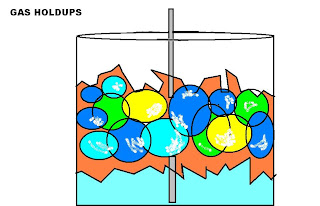
The behaviour of gases in fermentors is not simple. One could not simply visualize the behaviour of gases in the broth merely as the formation of gas bubbles that once formed will simply rises to the surface of the broth where it just collapse in the head space. The behaviour of gas bubbles in the fermentor is complex and one of the main problems faced in any fermentation studies is the problem of gas hold ups.
Gas hold up could be defined as the total volume of gas bubbles in the liquid at any instant during the gas-liquid contact processes. The gas bubbles constituting the gas holdups could be large or even microscopic bubbles. In prolonged cases of gas hold ups in fermentor there is the tendency for all the gas bubbles to come together or coalesce to form a very big bubble giving appearance of a static void within the fermentation broth
Inadvertently gas hold up will lead to the increase in total liquid volume of the broth in the fermentor compared to ungassed broth.
Gas hold up occurs either in situations such as:
1 Failure for the gas to rise up and explode into the head space of the fermentor
2 The bubbles are to small and recirculated in the fermentation broth for sometime
3 The gas bubbles are trapped in foams
4 Overgassing resulting in broth enriched with gas bubbles
5 The fermentation broth is too viscous that exert the pressure on the gas bubbles from rising
In theory having lots of gas bubbles is good because gas represents reservoirs of air or air carriers. A lot of gas means a lot of air supply ready to diffuse out into the broth. But the real situation is not really as imagined.
There are many factors which affect mass transfers of oxygen from the gas bubble to the broth.
A big bubble held up in the broth is not effective in the transfer of oxygen to the environment. A thick coating of foam or surfactant will reduce the efficiency of mass transfer of oxygen to the environment.
A stagnant bubble in the broth would even be anoxic as oxygen would have been depleted by the microorganisms and it will become toxic pockets instead
Gas hold up might even increase the chance of contamination especially as foams in the headspace.
Gas hold ups in the form of foam formation at the surface of the broth will lead to:
1 Separation of microbial cells from the broth
2 Death and lyses of the cells in the foam
3 Separation of other solids and nutrients from the broth
4 Poor control of mass transfers
5 Growth on walls
6 Poor ph control
REDUCING OR PREVENTING GAS HOLD UPS
-----------------------------------------------
There are a few possible ways of preventing or reducing gas hold ups. Some of these measures may not be economical or may even interfere with the fermentation process over a long run.
1 Breaking the gas bubbles physically by physical foam breakers
2 Adding anti foam to break the foam
3 Adjusting fermentation conditions
to be continued.....
Sunday, January 13, 2008
GAS HOLDUPS IN FERMENTOR
Labels:
aeration,
bubbles,
gas holdups
Subscribe to:
Post Comments (Atom)


No comments:
Post a Comment